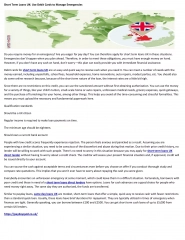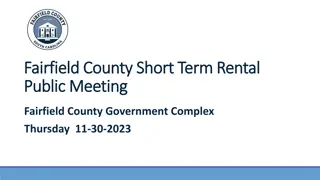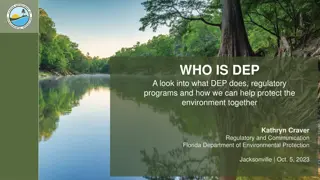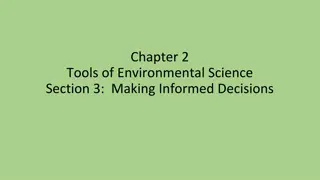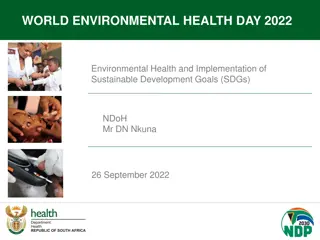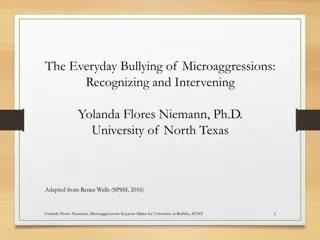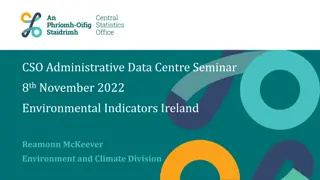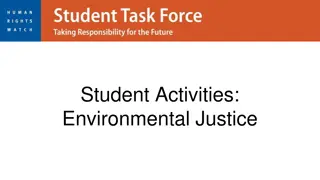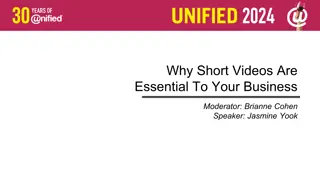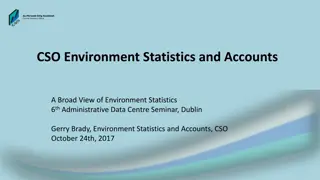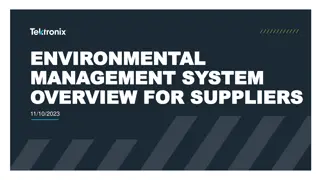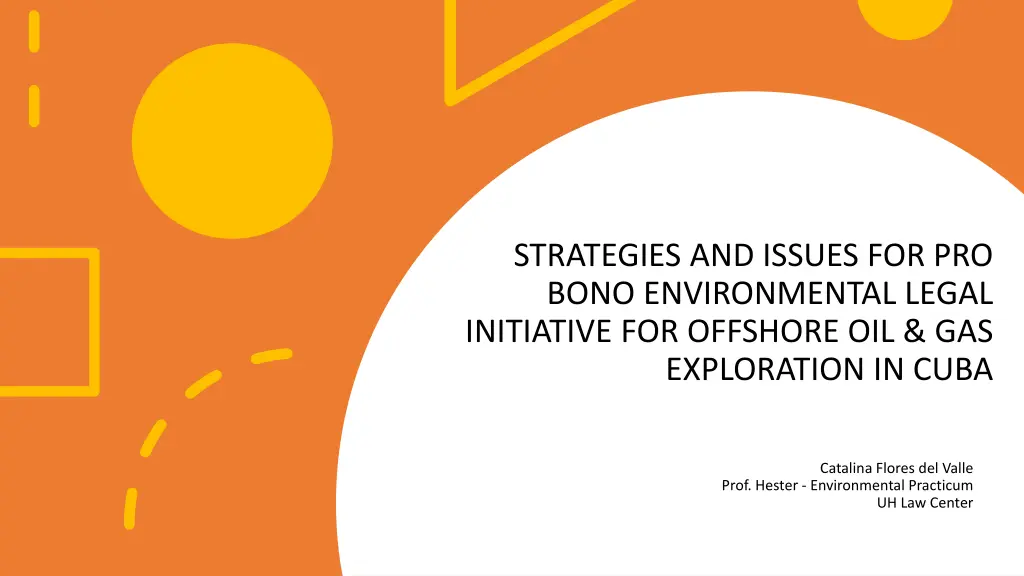
Pro Bono Environmental Legal Initiative for Offshore Oil & Gas Exploration in Cuba
Explore strategies and issues for a pro bono environmental legal initiative focused on offshore oil and gas exploration in Cuba. Learn about the country's unique ecosystem, marine and coastal protected areas, governmental authorities, and environmental legal background.
Download Presentation

Please find below an Image/Link to download the presentation.
The content on the website is provided AS IS for your information and personal use only. It may not be sold, licensed, or shared on other websites without obtaining consent from the author. If you encounter any issues during the download, it is possible that the publisher has removed the file from their server.
You are allowed to download the files provided on this website for personal or commercial use, subject to the condition that they are used lawfully. All files are the property of their respective owners.
The content on the website is provided AS IS for your information and personal use only. It may not be sold, licensed, or shared on other websites without obtaining consent from the author.
E N D
Presentation Transcript
STRATEGIES AND ISSUES FOR PRO BONO ENVIRONMENTAL LEGAL INITIATIVE FOR OFFSHORE OIL & GAS EXPLORATION IN CUBA Catalina Flores del Valle Prof. Hester - Environmental Practicum UH Law Center
Cubas geographic territory: more than 69.000 square mile: largest island in the Caribbean basin more than 1600 small islands, islets and keys. Ecosystem: 55% of the Caribbean endemic species first amongst the Caribbean island countries ninth worldwide (one of the most important islands worldwide for biodiversity). Marine and Coastal Protected Areas (MCPA) 10.400 square miles divided into 57 different areas. Environmental Background "Marine and coastal protected area - area within or adjacent to the marine environment, together with its overlying waters and associated flora, fauna and historical and cultural features, reserved by legislation or other effective means, including custom, with the effect that its marine and/or coastal biodiversity enjoys a higher level of protection that is surroundings. Permanent shallow marine waters; sea bays; straits; lagoons; estuaries; subtidal aquatic beds (kelp beds, seagrass beds; tropical marine meadows); coral reefs; intertidal muds; sand or salt flats and marshes; deep-water coral reefs; deep-water vents; and open ocean habitats."
Governmental Authorities Cuba State Department of Science, Technology and Environment (CITMA) CITMA s Agency for International Cooperation National Center of Protected Areas (CNAP) National System of Protected Areas (SNAP) Environmental Legal Background Regulatory bodies Law 81 in Environmental matters (1997) Regulation for Environmental Impact Assessment Process, art. 18 Environmental Impact Assessments (EIA)
Governmental Authorities State Department of Energy and Mines (MINEM) Union Cuba-Petroleo (CUPET) is the State Oil Agency that manages oil, gas and lubricants exploration, production and distribution businesses Oil Legal Background State Department for Foreign Trade and Investments (MINCEX) Regulatory bodies The Republic of Cuba Constitution (2019) Law 118 of Foreign Investments (2015) Republic of Cuba Civil Code Republic of Cuba Market Code Republic of Cuba Tax Law Law 81 of Environmental Matters National Security Law Other regulations and technical administrative rules
Memorandum of Understanding, November 18th, 2015 Environmental Law Enforcement Matters Cuba USA Relations Cooperation Agreement, January, 9th, 2017 To prevent, contain and clean up pollution caused by spills of hydrocarbons and other noxious and potentially hazardous substances in the Gulf of Mexico.
Protection of MCPAs and the offshore hydrocarbon business are intimately related. Protection of the marine biodiversity cannot be effective if the offshore hydrocarbon activities are not regulated under a strict body of law. In order for the companies to comply with the regulations there has to be a strict enforcement regulation body. Cuba s marine biodiversity is sufficiently rich and important as to deserve a special body of law just to protect it from any possible damage caused by the hydrocarbon industry Issues Direct and indirect/consequential impacts to marine biodiversity to coastal communities to the environment Socio-economic Impacts during regular operations and impacts caused by accidents
During seismic operations: Noise Emissions and discharges from equipment and vessels Interference with other resource users (Seasonal limitations) During exploratory and appraisal drilling activities Interactions Discharges, emissions and wastes Footprint During development and production Interactions Discharges, emissions and wastes Socio-economic cultural Potential Environmental Impacts
Analysis and data collection. Self-assessment to identify legal gaps that may need to be addressed The environmental framework and the regulations that affect the hydrocarbon industry should work together for a common purpose which is the conservation of Cuba s unique marine ecosystems and the improvement of the biodiversity management by setting regulation and industry standards according to International Conventions and Modern trends. Cuba has the opportunity to create a modern state of the art environmental regulatory system that may serve as a reference for other countries. Up to date analysis ecological infrastructure of coastal and ocean areas, and scientific data assessment on Cuba s marine biodiversity. Programming Strategy I
Constitutional Framework Analysis The Republic of Cuba is a socialist country Rights of liberty, equity, equality, solidarity, wellbeing and prosperity. State duties promote the sustainable development of the country protect and conserve the environment and to fight against global warming Citizens rights: right to receive truthful and accurate information from the State activities right to participate in the formation, exercise and control of the powers of the State promote legal initiatives, the reform of the Constitution and to learn about the management of the governmental entities The natural resources in Cuba s exclusive economic zone (EEZ) belong to the all the Cuban citizens Citizen duties Protect their natural resources, flora and fauna and watch for a healthy environment. Programming Strategy II
Implementation according to Constitutional Framework Natural resources are public affairs because belong to everybody Public affairs require public participation Efficient communication methods ensure transparency of processes and information Citizen participation principles Bona Fide Gender and race equality Transparency and equitability Effectively ensure all the stakeholders participation in the geographic impacted area Example: Face to face meetings High quality information is needed for effective participation in the decission making process Informed opinions lead to better decissions Better decissions carry more benefits to the society, to the economy and to the environment Programming Strategy III
1969 International Convention Relating to Intervention on the High Seas in Cases of Oil Pollution Casualties (Intervention Convention) 1969 International Convention on Civil Liability for Oil Pollution Damage (1969 CLC) and the 1992 Protocol to Amend the Convention 1971 International Convention on the Establishment of an International Fund for Compensation for Oil Pollution Damage (Fund Convention) 1972 Convention on the Prevention of Marine Pollution by Dumping Wastes and Other Matter (London Convention, 1972) 1972 Marine Mammal Protection Act (MMPA) 1973 MARPOL International Convention for the Prevention of Pollution from Ships (1973) 1982 UNCLOS United Nations Convention on the Law of the Sea 1983 Cartagena Convention: United Nations Environment Programme, Wider Caribbean Region (WCR) Protocol Concerning Co-operation in Combating Oil Spills in the Wider Caribbean Region The Protocol Concerning Specially Protected Areas and Wildlife (SPAW) in the Wider Caribbean Region The Protocol Concerning Pollution from Land-Based Sources and Activities was adopted on 6 October 1999 and entered into force on 13 August 2010. (Cuba has not ratified this one) International Conventions And Treaties To Apply To The New Framework I
1990 OPRC International Convention on Oil Pollution Preparedness, Response and Co-Operation 1992 Marine Mammal Protection Regulations 2000 Protocol on Preparedness, Response and Cooperation for Pollution Incidents by Hazardous and Noxious Substances (HNS Protocol) 2001 International Convention on Civil liability for Bunker Oil Pollution Damage (Bunker Convention) 2003 Protocol on Civil Liability and Compensation for Damage Caused by the Transboundary Effects of Industrial Accidents on Transboundary Waters (Industrial Accidents Protocol) 2004 International Convention for the Control and Management of Ships Ballast Water and Sediments (BWM, 2004) 2010 International Convention on Liability and Compensation for Damage in Connection with the Carriage of Hazardous and Noxious Substances and Protocol to the Convention (2010 HNS Convention) International Conventions And Treaties To Apply To The New Framework II

